Transformative UK-CGIAR Partnership Announced at the Global Food Summit 2023
British Prime Minister Rishi Sunak announced a new partnership between the CGIAR and the British Government at the Global Food Summit.
Read the full story.
British Prime Minister Rishi Sunak announced a new partnership between the CGIAR and the British Government at the Global Food Summit.
Read the full story.
The LIPS-ZIM program led by CIMMYT and partners, addresses livestock disease challenges in Zimbabwe. This collaborative effort aims to enhance livestock productivity and control diseases affecting smallholder farmers.
Read the full story.
New drought-resistant sorghum varieties bring hope for farmers in Africa
Scientists have identified drought-resistant, high-yielding sorghum genotypes that have the potential to revolutionize agriculture in dry regions of Africa. Sorghum, a staple food for millions in sub-Saharan Africa, has long been threatened by devastation from drought.
But now, researchers from the African Centre for Crop Improvement, the Institute of Agricultural Research (IAR), the International Maize and Wheat Improvement Center (CIMMYT), and the University of Life Sciences have discovered genetic resources that thrive under adverse conditions, yielding promising results and providing hope for a future that is more sustainable.
The study looked at 225 sorghum genotypes in various conditions, including non-stressed conditions and pre- and post-anthesis drought stress. The researchers used advanced statistical analysis, such as the additive main effects and multiplicative interaction (AMMI) method, to identify the most resilient and high-yielding genotypes.
The results revealed a vast diversity in the genetic resources of sorghum and provided a pathway for selecting promising genotypes for regions prone to drought. In addition, the study highlighted the significant impact of environmental conditions on grain yield, with genotypes showing variable responses to different growing environments.
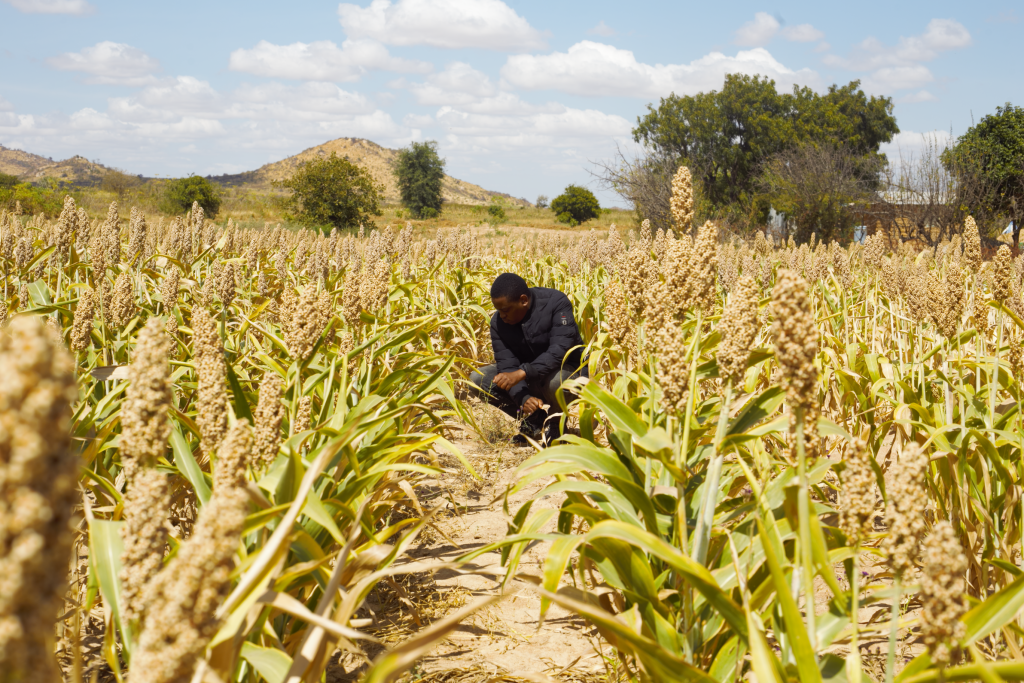
For example, genotypes G144 (Kaura Short Panicle-1) and G157 (Kaura Mai Baki Kona) displayed higher grain yield in drought-stressed environments and were among the top performers. Not only do these genotypes outperform registered cultivars, but they also possess traits valued by farmers, making them ideal candidates for future breeding programs. In addition to drought tolerance, genotypes G119 and G127 displayed remarkable stability and high yield under non-stressed conditions, showing their potential as all-around performers in a variety of environments.
Farmers in dry areas of sub-Saharan Africa that are characterized by pre- and post-anthesis drought stress stand to gain a great deal from these newly identified sorghum strains. Adoption of these high-yielding and drought-resistant genotypes could increase food production and strengthen farmers’ resilience against the effects of climate change.
The findings of these super sorghum genotypes offer farmers facing the challenges of climate change a glimmer of hope. By adopting these new drought-resistant strains, African farmers can improve their food security and strengthen their communities, paving the way for a more resilient and sustainable future.
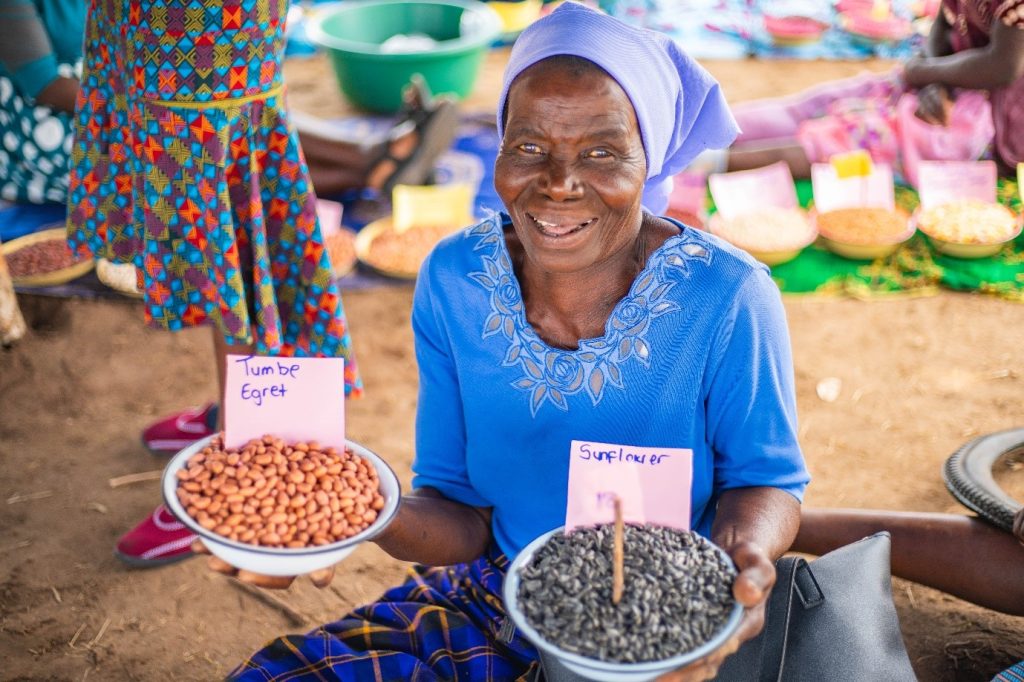
Farmers, stakeholders, and partners, including seed companies, Hamara Chicks, PHI Commodities, the International Livestock Research Institute (ILRI), BioHUB Trust (BHT), Kurima Machinery and Technology, and Zimplow Limited, participated in the Seed and Livestock Fair in the Mbire and Murewa districts of Zimbabwe, which showcased indigenous and improved seed varieties and different technologies to strengthen crop and livestock value chain systems.
Initiated by CIMMYT in 2022, as the CGIAR Initiative on Agroecology, these series of fairs have become instrumental in bringing agrodealers closer to farmers and showcasing sustainable technologies and innovations that have the potential to strengthen production systems. It was also an opportunity for the agroecology initiative team to provide feedback to farmers and stakeholders on ongoing activities and technologies that were being tested since the initiative’s inception in Zimbabwe. By adopting a multi-partner approach, these fairs bring local food systems actors together to ensure food and nutrition security and improved income for farmers.
“The agroecology initiative has been collaborating with an array of organizations and institutes that can support our mission towards promoting agroecology and improving farming production, including other CGAIR entities like IWMI and ILRI, Hamara Group, Ecolyfe, and PHI Commodities,” said Dorcas Matangi, research associate at CIMMYT.
This year’s edition of the seed and livestock fair “Fostering Synergies: Diverse Crops, Livestock and Inclusive Communities” advocated for enhancing synergies within the farm to foster sustainable agroecology transitions for resilient food and nutrition outcomes. With over 800 farmers and stakeholders participating, the event provided a vibrant platform for knowledge sharing, exploration of indigenous and improved seed varieties, and sensitization of innovative technologies.
“The seed and livestock fairs hosted by the agroecology initiative bring together farmers and food system actors from all walks of life to foster learning around agroecology, which includes the importance of diversity (crop and livestock) while also appreciating local innovations in the respective area,” said Jesca Mapfinya, a Murewa farmer.
The right seed, assures a good harvest
Various seed companies participated in the fair to showcase different seeds which are well adapted in Murewa and Mbire districts. Each agroecological region in Zimbabwe is unique, with adaptable seed varieties that are either landrace or improved. Local landraces and many underutilized crop species are adapted to weather and climate variability, climate change, and extreme weather such as drought and heat stress. Farmers indicated that their motivations for growing landraces are related to sustainable farming systems suitable for social, cultural, nutritional, and agronomic traits. Their place in rural communities remains important, providing much-needed functional diversity and social capital. Including improved varieties within the basket of options can further intensify production systems in these communities.
“Primarily, we sell seed varieties and build farmer capacity around appropriate agronomic practices. The seed fairs are a good platform to match seeds and systems and allows a farmer to provide feedback about our seed varieties and how they are performing in the respective areas,” said Onesmous Satenga, SeedCo.
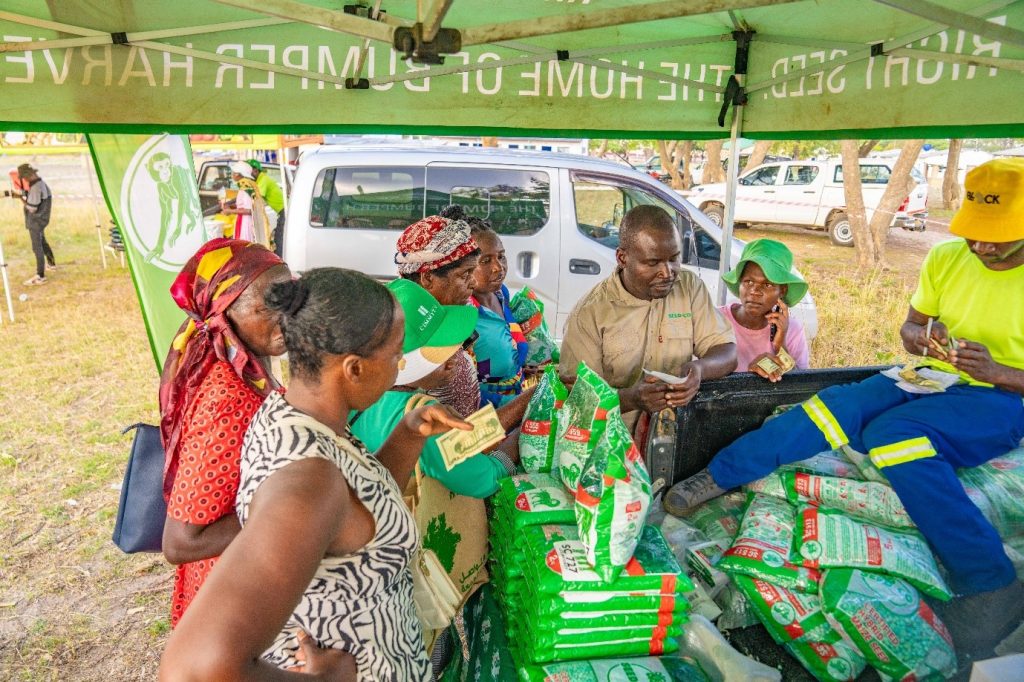
Building crop and livestock synergies
For the first time since the inception of the fairs, livestock such as cattle, sheep, goats, chicken and rabbits were displayed. Partners, including ILRI and the Hamara Chicks, who are into sasso chicken and feed production, reiterated the importance of crop diversity for improved livestock nutrition. ILRI and the Grasslands Research Institute exhibited various local feedstocks and alternative livestock feed grasses and also presented several feed formulations. Farmers also provided feedback on the feeding strategies employed for different livestock.
“We feed cattle with poultry litter, maize grain, maize stover, and groundnut shells in various proportions depending on the availability of these feed sources. Forage legumes such as velvet bean (mucuna pruriens) and lablab (lablab purpureus) have been introduced, and we have started to grow these for feed,” said Samson Tashaya, Murewa farmer.
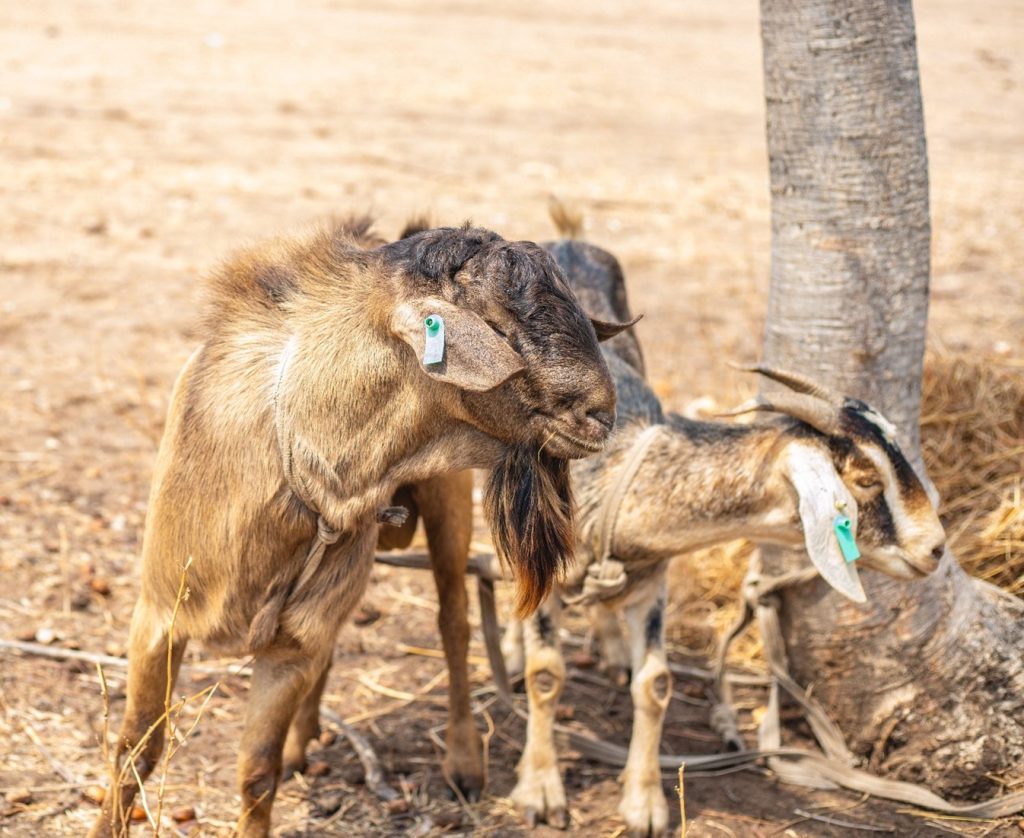
Of keen interest to farmers and stakeholders was the sasso breed of chickens that the Hamara Group was promoting.
“We have recently joined as partners with CIMMYT and are promoting hybrid chicken production, especially sasso, here in Murewa ward 27 and 4. This is our first time coming to this seed fair, and it was a learning opportunity. The interactions with farmers were really good,” said Alan Norton, team leader at Hamara Chicks.
Modernizing smallholder production systems
Mechanization experts from Kurima Machinery and Zimplow shared their recommendations at the fair. They acknowledged that farmers rely heavily on scarcely available labor and production activities that are backbreaking. They advocated for modern production systems to produce more food and support economic transformation. Experts from Kurima Machinery and Zimplow demonstrated several machines that could aid farmers in various on-farm activities.
“This fair has come at the right time as I begin land preparation for my pfumvudza (conservation agriculture plots). I have seen how the basin digger works, and I am keen to purchase an instrument to make my work much easier,” said Chief Chisunga, Mbire.
“This crop season’s outlook is still unclear, but weather experts have warned of an intense El Nino event likely to happen in the second half of the season. Technologies such as conservation agriculture can ensure good moisture retention in crop fields, and it needs to be paired with good agronomic practices,” said Tafadzwanashe Mabhaudhi, climate and food systems expert.
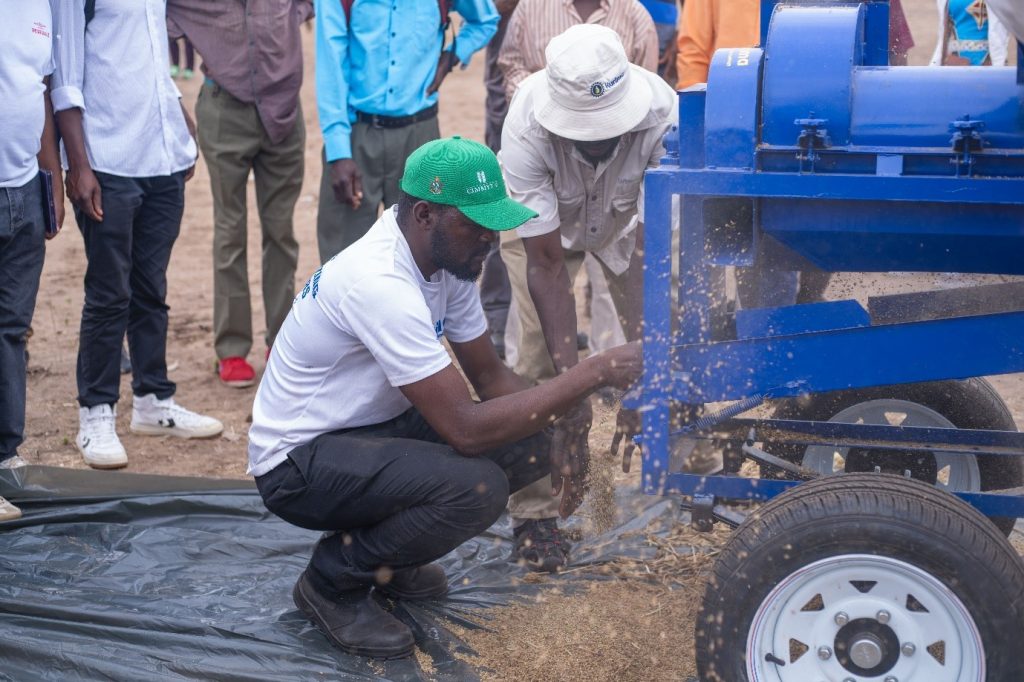
CIMMYT Director General, Bram Govaerts, praised China’s recent efforts to curb its reliance on food imports and increase funding for technology-driven breeding techniques, including gene editing. Govaerts suggested such measures have managed to shield China from the unfolding global food crisis that is caused by a mix of factors such as regional conflicts, climate change and rising protectionism.
Read the full article.
CIMMYT Ethiopia signed a memorandum of understanding (MoU) in November 2023 with the Addis Ababa-based private food processing company Alvima Foods Complex Plc, in an effort to encourage durum wheat production among smallholder farmers and create market linkage in selected woredas of Oromia and Amhara regional states.
The MoU, which is part of CIMMYT Ethiopia’s overall durum wheat project aiming to reinvigorate durum wheat production in the country, was signed by Workneh Rikita, Alvima general manager, and Kindie Tesfaye, CIMMYT Ethiopia’s senior scientist.
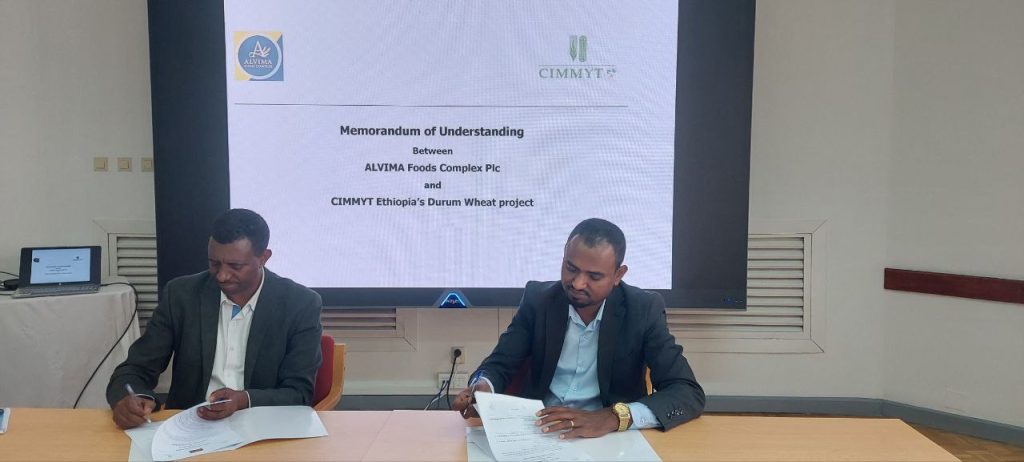
The MoU aims primarily to create market linkage between farmers and manufacturers, in a context of a sharp decrease of durum wheat production. “Prior to the 1980s, 80% of the wheat produced in Ethiopia was durum, but in 2016 our nationwide research on wheat showed that the durum wheat coverage was 5%, which stands in contrast to the country’s effort to industrialize the economy and substitute import goods with local produce”, said Kindie Tesfaye, CIMMYT durum wheat project leader. “We, as CIMMYT, want to encourage farmers to produce good quality durum wheat in quantity, and teach them about contract farming by creating market linkage with produce receivers like Alvima.”
“Cooperation, not business venture”
Established in 2011, Alvima Foods Complex initially centered its operations around importing and exporting agro-food products. In 2017, the company set up a pasta and flour processing factory and contracted 800 farmers to produce durum wheat. “At first, our objective was to produce premium quality pasta, unlike most processing companies in the country which produce pasta from hard wheat or mixed wheat,” said Workneh Rikita, Alvima’s general manager. In the absence of binding rules, the project failed and Alvima resigned to import durum wheat. “The law on contract farming was constituted recently and the difficulties to access foreign currency (therefore to import goods), which led us to turn our attention back to our initial project”, said Workneh Rikita.
Alvima Foods Complex general manager added that his company didn’t sign the agreement as a business venture but as an advantageous cooperation to learn from. He thanked CIMMYT for agreeing to work with his company and expressed his hopes for its success.
The current durum wheat market in Ethiopia is unpredictable as prices are set by the brokers, which heavily disadvantages the growers. The objective of the memorandum of understanding is to address such market challenges faced by farmers, affording them guaranteed market opportunities at a fair price.
As part of the agreement between Alvima Foods Complex and the durum wheat growers in target districts of the Amhara and Oromia regional states, CIMMYT will leverage on its expertise to help the farmers produce more and in good quality. Alvima will access the produce from farmers’ cooperatives directly, without the intervention of middlemen, to guarantee better incomes to producers. Moreover, CIMMYT is training farmers on use of climate information, accessing climate advisories, video-based production trainings, and crop disease management.
“If the farmers get the premium price for their produce, they will be encouraged to continue producing better wheat,” said Kindie Tesfaye. “We want the cooperation to be sustainable and to create direct links between farmers and local food processors (such as AVLIMA). The MoU will also benefit Ethiopia by decreasing imports of processed food items.”
A multilayered challenge to durum wheat production
Supported by the Bill and Melinda Gates Foundation, CIMMYT and Digital Green (an organization creating digital tools to assist farmers) have been conducting durum wheat improved varieties were insufficiently promoted; the seed was not made adequately accessible to farmers; productivity was perceived by farmers as being low; and market linkage was poor. These multilayered challenges led farmers to prioritize bread wheat varieties, according to Kindie Tesfaye.
In response, CIMMYT structured its support around three main pillars: the organization helps farmers access seeds together with Oromia’s Seed Enterprise, provides farmers with digital advisory services to improve their productivity, and works with the private and public sectors to upgrade market linkages, as with the memorandum of understanding signed with Alvima Foods Complex Plc.
The Gwanda Provincial Veterinary Laboratory, now renovated as part of the Livestock Production Systems in Zimbabwe (LIPS-ZIM) project, will help detect and control livestock diseases. CIMMYT is working with ILRI and other partners to improve livestock productivity and support smallholder farmers.
Read the full story.
In the vast landscapes of sub-Saharan Africa, where agriculture is the backbone of many communities, the quest for improved maize varieties is a vital step for ensuring food security in the face of climate change. Women, who represent approximately half the clients of maize breeding programs, have been essential in the realm of agricultural research. While significant gender-based differences in trait preferences exist in many African-staple crops, these appear less drastic in maize. However, there are gendered differences in management practices and productivity in maize-based systems.

Recognizing the need to bridge this gap, the CIMMYT-NARES (National Agricultural Research and Extension Systems) regional maize breeding networks in eastern and southern Africa have embarked on a transformative journey to empower farmers, especially women, through their innovative approach to maize breeding. The breeding networks are focused on ensuring smallholder farmers have access to a steady stream of climate-resilient and nutritionally enriched maize varieties that thrive in today’s stress-prone environments. To ensure these new maize varieties meet the needs of diverse users, including women, the breeding networks continue to adapt approaches to increase gender-responsiveness.
Linking science with the realities on the ground
Testing the performance of potential new maize hybrids coming from the breeding pipelines within farmers’ realities is critical to the ultimate success of these new varieties. In collaboration with over 400 farmers in southern Africa, the CIMMYT-NARES maize breeding network conducts extensive on-farm trials to evaluate the performance of these new maize varieties. A similar approach is adopted in eastern Africa. What sets these trials apart is the fact that over 40% of these trials are led by female plot managers. Farmers evaluate these varieties within the context of their own realities, including their own management practices, and provide valuable feedback to the breeding teams on the potential of new varieties.
By involving women in decision-making processes, CIMMYT-NARES networks ensure that their preferences and needs are considered when selecting the most promising hybrids for product advancement, announcement to partners, varietal releases and ultimately commercialization. This inclusive approach not only empowers women but also harnesses the collective knowledge and experience of the farming community. CIMMYT’s research recently showed that there is a relatively high degree of joint management within maize plots, and since 2022, the on-farm trials included a target of approximately 30% jointly managed plots.
Gender is only one axis of social difference that impacts agricultural production, variety selection, and end uses. Social differences including marital status, age, education level, ethnicity, wealth, access to capital, market access and livelihood orientation do play a role in the adoption of new varieties and farm productivity. By embracing the diversity within farming communities, CIMMYT-NARES networks are actively working towards understanding different farm types, while ensuring that the improved maize varieties are tailored to meet the diverse demands of the regions.
As the CIMMYT-NARES maize breeding networks continue to make innovative strides in breeding climate-resilient and nutritionally enriched maize varieties, they are not only transforming agriculture but also empowering individuals and communities. Through collaborative efforts, with the woman farmer at the heart of the approach, they are paving the way for a future where farming communities can thrive and contribute to food and nutritional security.
Intention, collaboration and commitment are critical to bridging the research and practice gap. Gender development practitioners and researchers from CGIAR centers, universities, national agricultural research and extension systems (NARES), civil society, and donor representatives this week shared insights from their research and work at the gender conference in New Delhi, India.
The discussion and exchange promises to create collaborations and opportunities devoted to improving the conditions and agency of women, youth and Indigenous communities in the Global South. “Transformative research can lead to meaningful impact,” said Angela Meentzen, senior gender researcher at CIMMYT. “We have been looking forward to this conference because coming together as researchers, scientists and development practitioners, we can discuss and share insights from each other’s practices and experiences from the field.”
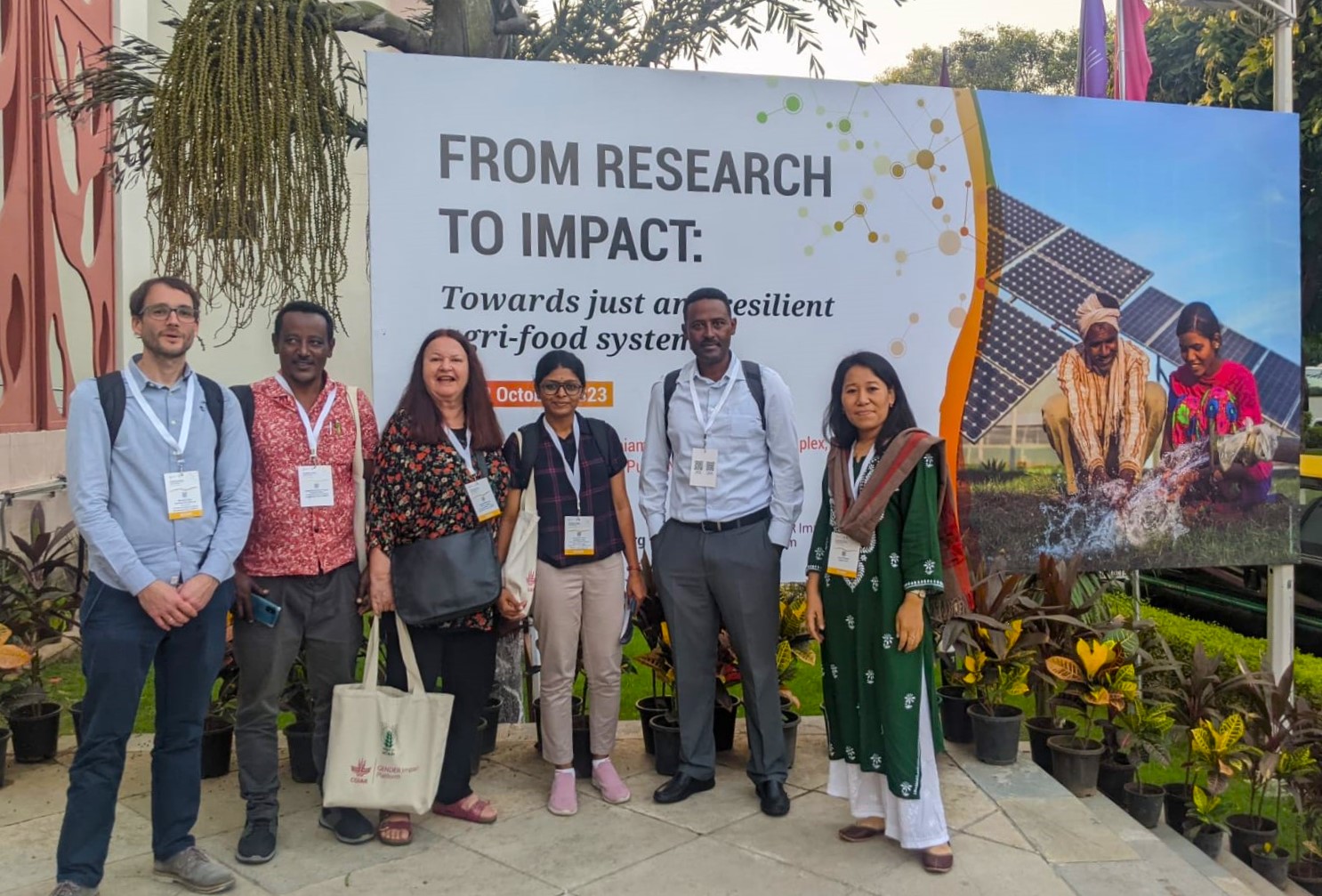
Leading researchers and scientists from CIMMYT Asia and Africa presented their research and enriched the gender discussions at the conference. Meentzen said that CIMMYT is proud to support gender research that contributes meaningfully to transformative change and impact.
Below are highlights of four research poster presentations by our researchers (of the six presented by CIMMYT) at the conference:
Scientist Vijayalaxmi Khed examined how women manage excess workload (working inside and outside the house), a clear trade-off between productive and leisure time without change in domestic responsibilities. Due to domestic workload, she found that women’s time away from farms does not translate into leisure. Another important finding was that women with more agency had less time for leisure, unlike for men.
In her poster presentation, she concluded that rural women’s nexus of time poverty and decision-making has “clear implications for the development and diffusion of laborsaving technologies in agriculture.”
Working on the same study with Khed, Vijesh Krishna explored the relationship between women’s involvement in agricultural activities and decision-making. His presentation, ‘Farm managers or unpaid laborers?’, from the study covering 347 wheat-farming households across two years, concludes that “despite playing a crucial role in wheat farming in central India, most women lacked the ability to influence decisions.”
Gender-intentional maize breeding for better adoption and productivity in sub-Saharan Africa
Michael Euler, agriculture and resource economist, in his poster presentation explained how an on-farm trial to improve gender-intentional breeding and varietal adoption in maize was designed by CIMMYT breeders and researchers.
The study hypothesized that gender dynamics in household labor allocation and decision-making in maize systems influence trait preferences and farmers’ adoption of varieties. So, researchers conducted on-farm trials and household surveys with individual women and men household members to capture differences in their trait preferences in maize cultivation—production systems, seed demand and seed access—with 800 smallholder farmers in Zimbabwe and Kenya.
Euler emphasized the influence of socioeconomic and agroecological factors, including biotic–abiotic stress, in the household decisions on maize varietal adoption.
He concluded that the study results will help “guide the product development of regional maize breeding programs and strengthen communities’ adaptation to the changing environmental conditions for maize cultivation.”
Adoption of a weeding technology may lead to labor displacement of marginalized women laborers
Presenting a poster for the same session as Euler, Maxwell Mkondiwa—in a study coauthored with colleagues Khed and Krishna—highlighted how rapid diffusion of a laborsaving technology like herbicides could exclude the marginalized further. The study occurred in India’s state of Bihar, looking at nonfarming rural poor, primarily women, from socially marginalized groups.
From data on chemical weeding, the study analyzed the technology’s impact on inequality— highlighting how marginalized women laborers who work on manual weeding are then replaced by men who apply herbicides.
He stressed that not enough research is devoted to understanding whether farmer adoption of laborsaving technologies worsens economic inequalities or reinstates labor into better tasks. “We hope the evidence we generated will help researchers and policymakers develop relevant actions toward more inclusive innovations, and support laborers with new skills for the transitions,” said Mkondiwa.
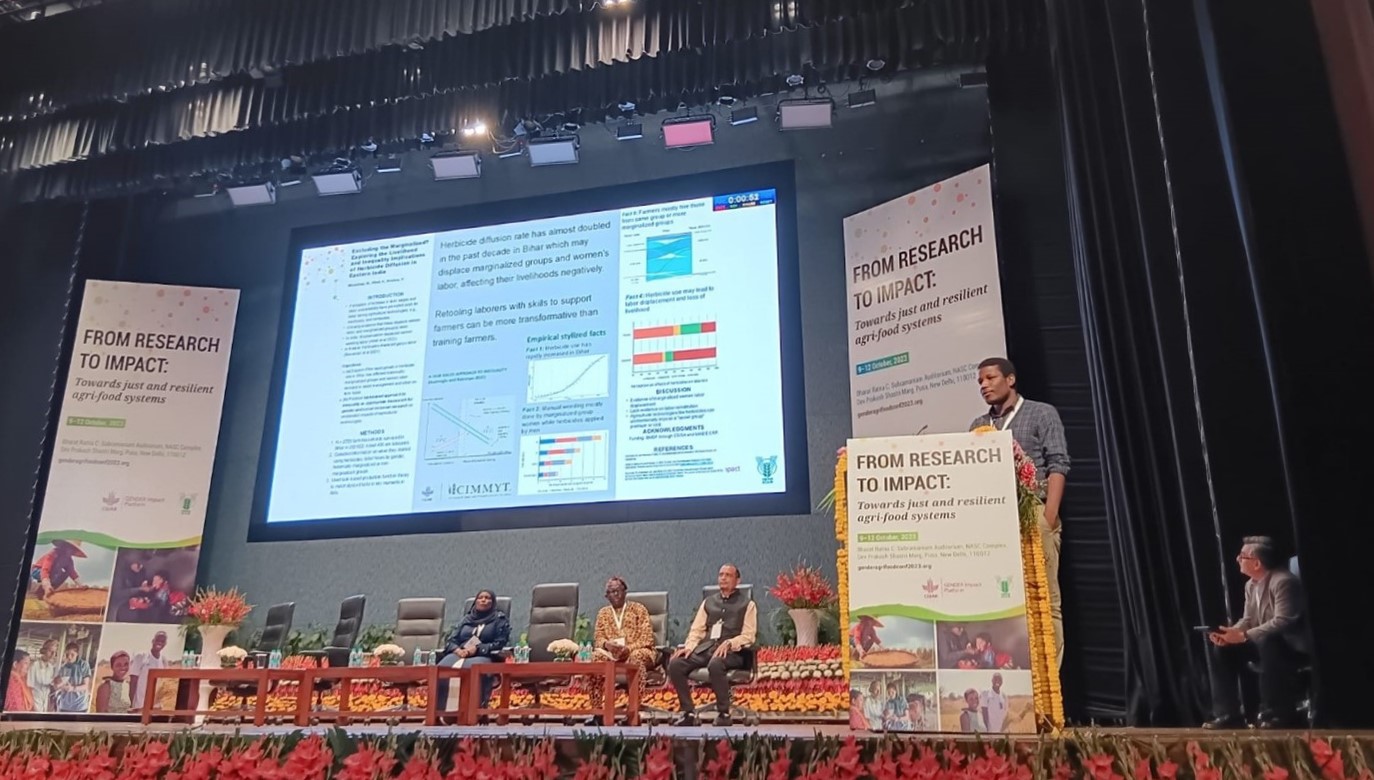
Women exhibit limited technical knowledge and experience social benefits differently in male-headed households of CASI technology adoption
Emma Karki, in her poster, explained that there is limited knowledge of the impact of technology adoption on women in a male-headed household in South Asia—with decision powers generally resting with male household members. The research tried to understand the gendered differences in the evaluation of technology adoption in male-headed households using conservation agriculture-based sustainable intensification (CASI) technology as a case study.
The study focused on identifying the commonalities and differences in the experiences and evaluation of CASI technology. Results indicated that “despite technology adoption, women had limited mechanistic understanding compared to men, with similar limitations on women’s time use and capacity development,” said Karki.
For future CASI promotion, Karki concluded: “Reducing information gaps and incorporating technological preferences of women needs prioritizing, including creating opportunities for them to access knowledge and engage both men and women in critical discussions surrounding gender norms.”
Similarly, Moti Jaleta’s research presentation highlighted the challenges of mechanization adoption for smallholder farmers in Ethiopia, primarily women. “Intentional research, whether in gender or social development, helps identify problems and opportunities for change,” endorsed Jaleta.
Meaningful research helps achieve gender and social inclusion goals
The ‘From Research to Impact: CGIAR GENDER Impact Platform and ICAR Conference 2023’, between October 9-12, 2023, in New Delhi, gathered researchers from 68 countries. In her inaugural address at the conference’s opening, the President of India Smt. Draupadi Murmu affirmed, “For ecologically sustainable, ethically desirable, economically affordable and socially justifiable production, we need research which can enable conditions to reach these goals.”
At the end of the four-day conference—with 60 research presentations and six plenary sessions—the organizers and participants reflected on their resolve ‘From Research To Impact,’ and the promise to recognize and collectively address the gender and social inequities in agrifood systems development.
Bhumi Shara Khadka is a 35-year-old community business facilitator who has made significant strides in agriculture and community development. Her journey began after completing training in sales skill development and technical capacity building for community business facilitators (CBF) organized by the Cereal Systems Initiative for South Asia (CSISA) in June 2022 and April 2023, respectively. This training opened up new opportunities, and she soon secured a job as a CBF. However, her ambitions didn’t stop there.
In February 2022, the Cereal Systems Initiative for South Asia (CSISA) recognized her potential and recommended her for a role as a community business facilitator with Laxmi Agrovet, a local agribusiness. To prepare for her new position, Ms. Khadka underwent additional training in various areas, including running sales meetings, farm mechanization, post-harvest handling and the fundamentals of sales and marketing. With these tools in hand, she set out to make a difference in the lives of farmers and the broader community.
To date, Khadka has conducted 97 sales meetings with farmer groups where she explains improved production methods, plant protection, post-harvest handling and how to market agriculture products effectively. She also demonstrates and sells Laxmi Agrovet agri-inputs such as seeds, fertilizer and tools. She gets a 20% commission on sales, bringing her an average net monthly income of NPR3,375 (US$26). Her role as community business facilitator also involves linking farmers with the local government agriculture program. As a result of her efforts, three farmers have each acquired a mini power tiller at a 50% subsidy.
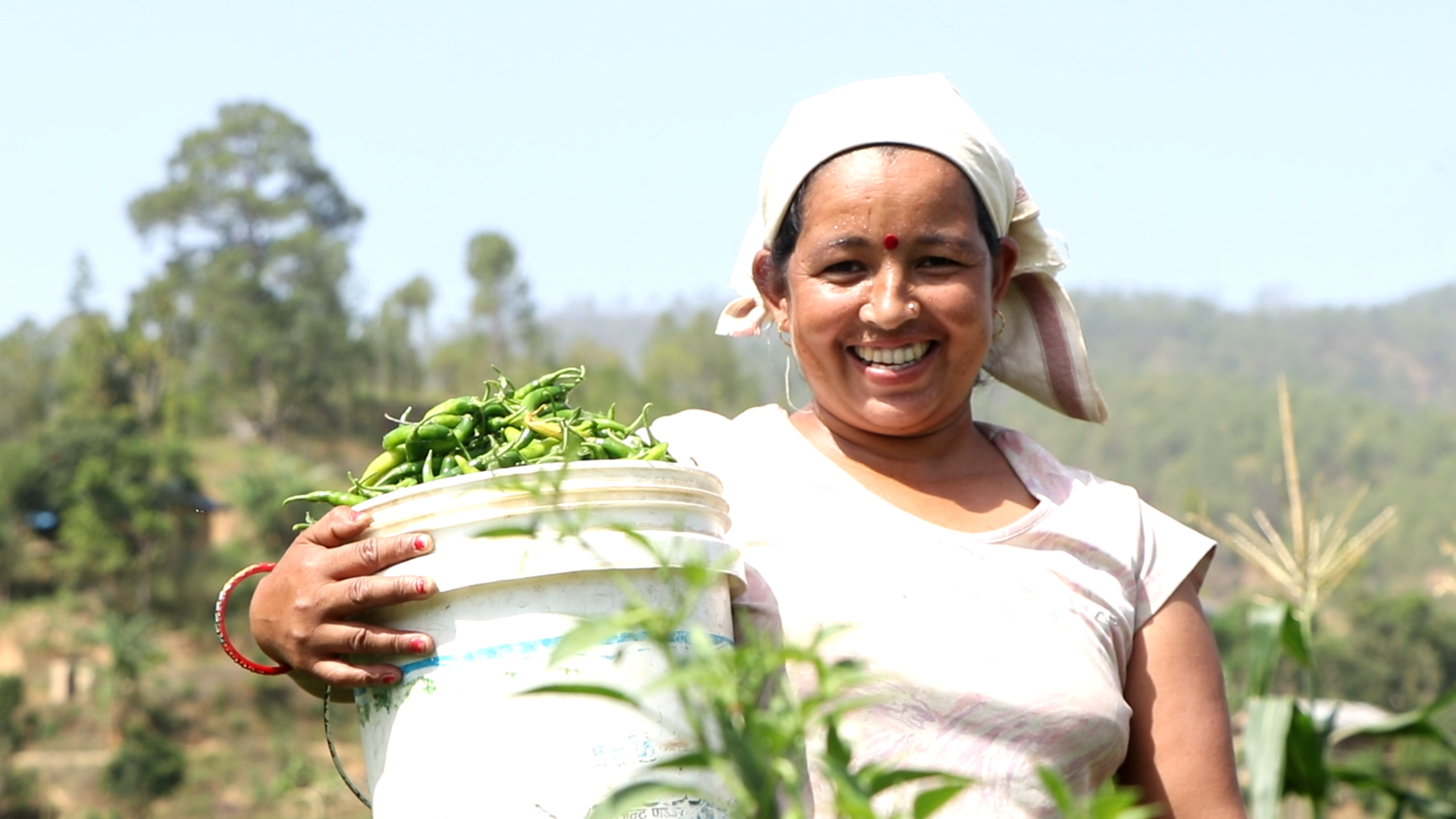
Inspired by Khadka’s example, Chitra Bahadur Rokaya, acting director of the Agricultural Regional Directorate in Surkhet, Nepal, has expressed his desire to visit farmers and learn more about the activities of community business facilitators like Khadka during the technical capacity-building training to CBF in April 2023. Rokaya has expressed gratitude to trainees who attended the IPM training organized by CSISA and would visit the field sites of the trainees, if possible.
Khadka has also used her knowledge as a business facilitator and IPM trainee to establish her commercial vegetable farm, which, with her investment and CSISA’s technical support, now occupies five ropani (0.01 hectares). Her husband helps out and Bhumi sells the produce at local markets in Melkuna and Badichour, Surkhet, with traders often coming to the farm to buy from her directly. Last year, she earned NPR227,000 (US$1,733) of which her net income was NPR63,500 (US$485). Since starting the farm, the family’s food habits and those of her neighbors have changed for the better. Last year, the family kept a quarter of the vegetables she produced for their consumption, and she gave about 10% to neighbors.
Last year, under Khadka’s facilitation, 48 farmers cultivated vegetables on an average of 0.02 hectares each, each achieving an average net profit of NPR63,500 (US$485). Khadka also owns a power tiller, which she rents out for others to use, earning NPR35,000 (US$267) last year from this service provision activity.
In addition to her business and professional success, Khadka completed high school in 2014, underlining the significance of her accomplishments. Khadka’s remarkable journey is an inspiring agriculture success story, showcasing the transformative power of women empowerment in rural communities. Her dedication, knowledge and entrepreneurial spirit have improved farmers’ lives and elevated the entire community’s access to nutritious food. Her unwavering commitment to her work has brought her well-deserved recognition, and she is a beacon of hope for others in similar fields of endeavor.
CIMMYT holds the fourth edition of seed and mechanization fairs in Mwenezi and Masvingo rural districts, and introduces a groundbreaking mechanization component thanks to the Feed the Future Zimbabwe Mechanization and Extension Activity.
Read the full story.
As hotter temperatures and drought become the norm in places used to growing wheat, yields will be reduced, climate change will have some effect on most of the world’s wheat. CIMMYT is working to strengthen seed systems as demand for staple crops like wheat is only expected to increase as the climate crisis makes the world’s food system more vulnerable.
Read the full story.
Seed the World Group hosted a webinar to find a common ground between public and private breeding programs in North America and some possible paths forward. Fernando Gonzalez, a retired plant breeder from CIMMYT mentioned a noticeable uptick in the involvement of the private sector in breeding programs in Mexico.
Learn more about the primary goals underlying public and private breeding efforts.
Women play a critical role in the future of food security. Female farmers face a significant disadvantage before they ever plow a field or sow a seed. Farming is a challenging profession, and it is even more challenging for women when they perform these functions whilst facing numerous constraints.
Nur-A-Mahajabin Khan, communications officer, showcases how fodder chopper technology is improving the lives of women farmers in rural Bangladesh.
Read more.
 How many times have we seen innovative ideas launched into the marketplace, seeming to offer answers to key problems, only to see them fail to make the impact that we expected? In the modern world, having a great idea is not enough to ensure market success. Even when new products, processes or technologies have been carefully and successfully tested in trials and studies, the process of scaling and launching them often leads to disappointing results.
How many times have we seen innovative ideas launched into the marketplace, seeming to offer answers to key problems, only to see them fail to make the impact that we expected? In the modern world, having a great idea is not enough to ensure market success. Even when new products, processes or technologies have been carefully and successfully tested in trials and studies, the process of scaling and launching them often leads to disappointing results.
History of the Scaling Scan
“The Scaling Scan is a necessary breakthrough for those connected with meaningful impact. The Scaling Scan is accessible, practical, grounded in the reality, and most importantly, a watershed rethinking the ‘bigger is better’ logic of scaling.”
Rob McLean, CIMMYT scaling coordinator senior program specialist in Policy and Evaluation at IDRC and author of “Scaling Impact”
The Scaling Scan was developed to improve this process and ensure that new innovations have the best chance of success. Traditionally, scaling an innovation has often resulted in “linear” thinking, where the project team focuses on the advantages of their new product and relies on these for launch. The Scaling Scan encourages teams to broaden their thinking into areas within the overall private and public sector environments where they may have less experience, but which can greatly help or hinder the success of new ideas. It looks at 10 “ingredients” to consider, discuss, and develop strategies to address — ranging from end-user financing and business cases to national strategies and regulations.
The first version of the Scaling Scan was launched in 2017 following cooperation between scaling expert Lennart Woltering at CIMMYT and the Public Private Partnership Lab (PPPLab), a research consortium based in the Netherlands. A second, updated version was released the following year. The tool has been implemented through workshops held around the world, with trained moderators to encourage discussion, share ideas and develop expertise. These discussions resulted in five action steps:
More than 1,200 participants attended the workshops that were held in English, Spanish and French. Half of the workshops were held in Africa, with the rest divided between Asia and North and South America, including 11 in Mexico. In 2022, an online version was made available through the launch of a new website, https://scalingscan.org/ with support from the Deutsche Gesellschaft für Internationale Zusammenarbeit (GIZ) and the One CGIAR Mitigate initiative. This has further increased the availability of and access to scaling information.
“The Scaling Scan pushes users to go beyond a narrow focus on scaling an innovation. It is a great tool that enables practical thinking about the multiple pathways to impact at scale and the range of stakeholders that need to be considered in scaling process.”
Kelly Hayley Price, DRC senior evaluation officer
3rd edition Scaling Scan Launch
On September 14, 2023, the 3rd edition of the Scaling Scan will be launched. With the support of GIZ, FAO, Alliance, and SNV, the tool has been enhanced to include some changes inspired by discussions at the workshops. There is increased consideration of gender roles and how these might affect, or be affected by, a scaling program. Likewise, the impact of climate change is also included. In terms of usability, the Scaling Scan has been adapted to make it more accessible to use without a moderator, meaning that users will be able to benefit even if they have difficulty getting to a workshop. It has also been designed to make it easier to customize the Scaling Scan to fit one’s own needs, rather than requiring the standard version used in workshops.
To find out more about the Scaling Scan, please visit https://scalingscan.org/, or email e.valencia@cgiar.org for more information.